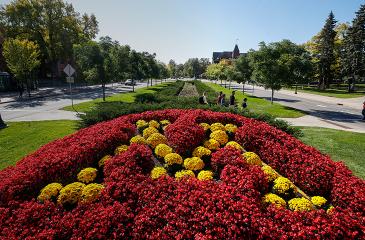According to an AARP survey of adults age 65-plus, 87 percent want to stay in their current home and community as they age. Among people age 50 to 64, 71 percent of people want to age in place.
What does this mean for community planners and homeowners? It turns out, plenty.
For baby boomers, the 78 million Americans born between 1946 and 1964 comprising nearly 26 percent of the U.S. population, housing designed to help more people stay independent as they age will become increasingly important. For many, this means modifications to an existing home. Others entertain thoughts of moving to a more accessible home. Community planners have both the ability and desire to keep a community vital and resilient for residents of all ages.
“There is no downside to planning ahead for a safer, accessible and more comfortable home,” said Marilyn Bruin, PhD, professor of housing studies at the College of Design and an expert in senior housing, urban neighborhoods and community development. “When we create a home to age in place, we are taking control of our futures by preparing to maintain our independence longer.”
Vice President for Clinical Affairs Jakub Tolar, MD, PhD, believes aging is one of the most pressing health concerns for our state and the people we serve.
“In the past, ‘aging’ seemed to be viewed as a health issue. Yet, aging touches every aspect of research and practice, even those outside of the health care fields. I am grateful for the exemplary work that Dr. Marilyn Bruin and her colleagues are doing to improve and extend independent living for Minnesotans and others," said Tolar.
In 2017, the College of Design surveyed residents in St. Paul, Minnesota’s Highland Park and Mac Groveland neighborhoods to determine how homeowners view their home’s accessibility. A slight majority thought their home was not accessible and one-half indicated they would move to a more accessible home.
“So many of today’s sought-after design trends also work well for aging in place,” said Bruin. “Open-concept design, one-level living, a front door with a wide entrance, sliding barn doors and smooth flooring surfaces such as hard wood are trendy, but they are also great options for accessibility.”
According to Bruin, policy makers could promote incentives to mitigate risks to both homebuilders and buyers seeking homes to age and live in place. Along with listening to aging residents, cities could also offer residents access to information, such as a resource library.
“I have never met a community leader or public official who didn’t want to keep all aging residents in their community,” said Bruin. “If we put as much energy into the housing needs of baby boomers and seniors as we do into first time homebuyers, we would have parity.”
Bruin notes that when homeowners plan ahead, it enhances the value of their real estate in the long-term.
“It’s an investment,” said Bruin. “Building or modifying homes designed to help homeowners safely age in place prevents injuries, saves joints, and makes others who come to visit feel more welcomed.”



